#I for one would love to donate for her queer joy and healing
Text
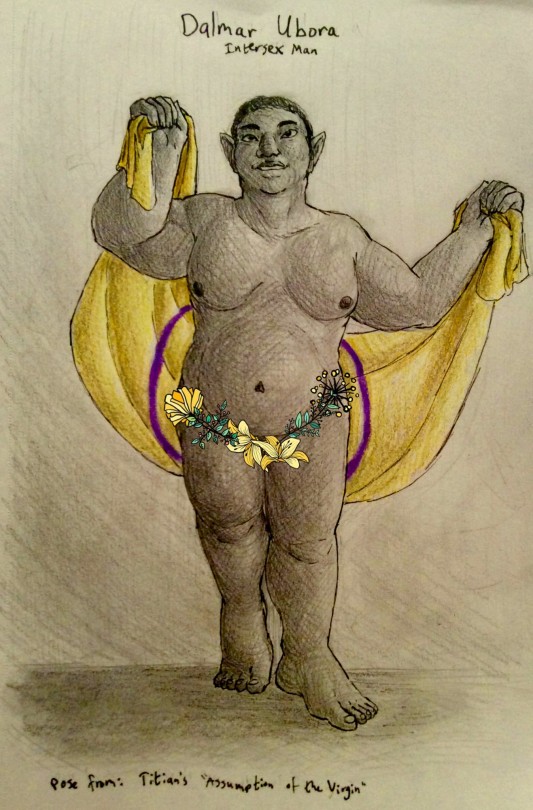




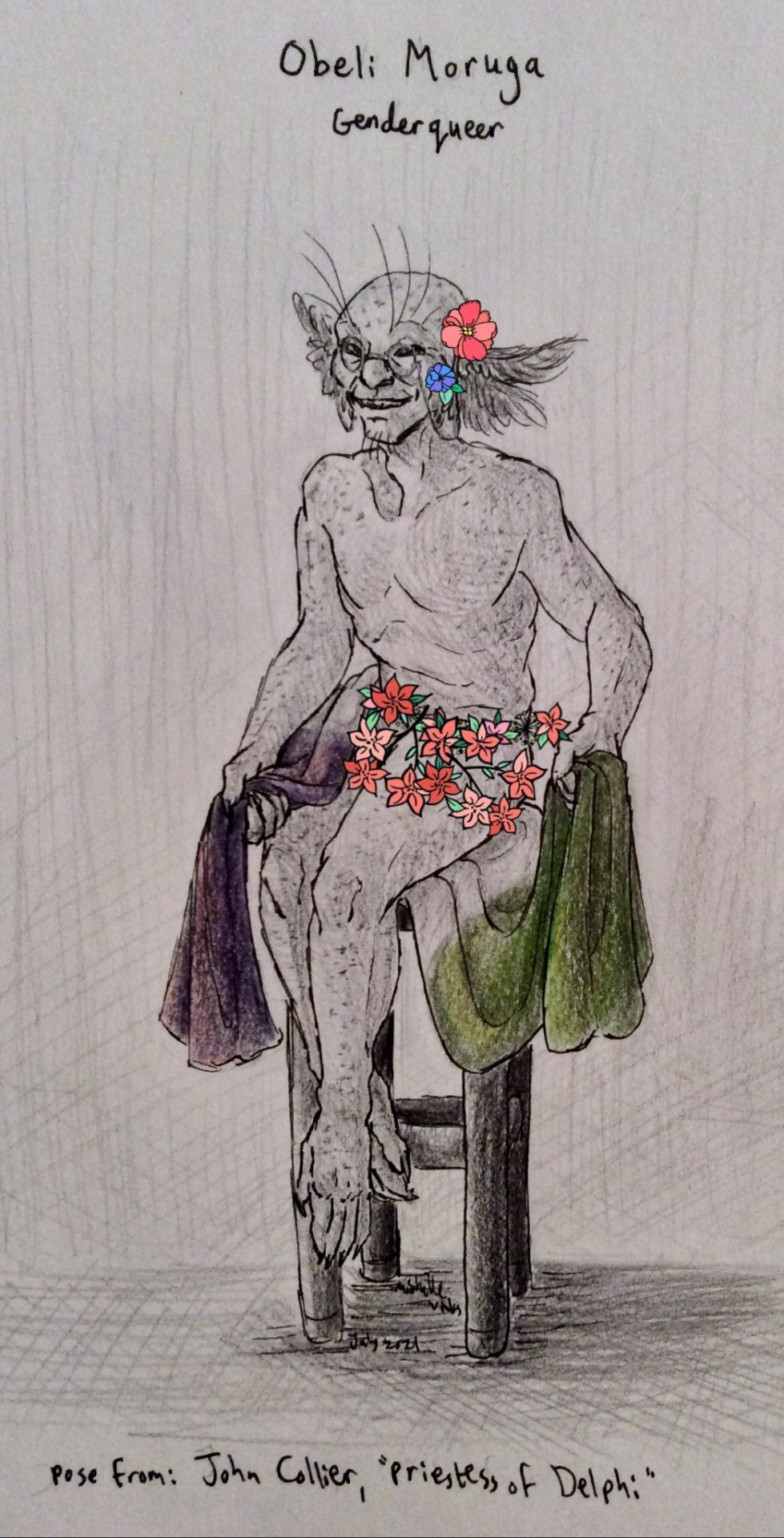
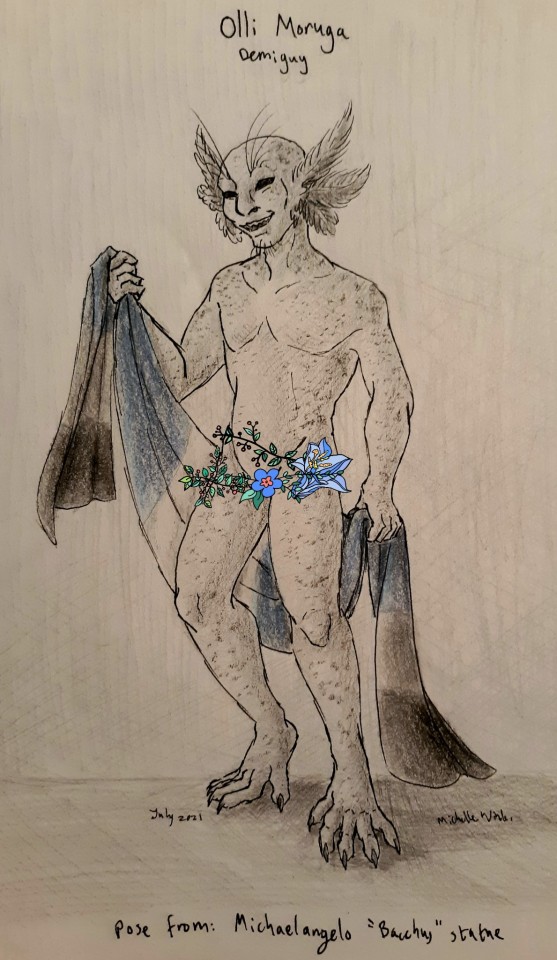
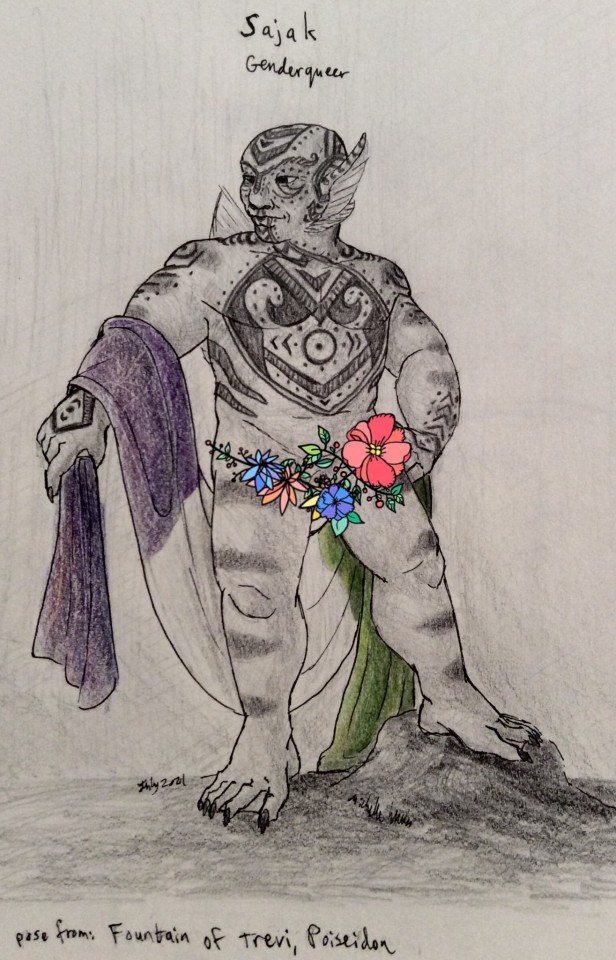
(image description: eight sketchbook drawings of characters holding a variety of pride flags, all nude and posed in ways that match some old fine art pieces. The nudity has been censored with cute digital flower stickers. end description.)
Characters:
Dalmar, intersex man. Kouto, nonbinary. Chacha, agender. Parva, nonbinary. Xulic and Kidron, genderqueer. Obeli (or Abuela) Moruga, genderqeer. Olli, demiguy. Sajak, genderqueer.
Genderqueer is kind of my default for "well, biologically and culturally, they already don't have binary sex or gender, so they kinda default to genderqueer." And I know maybe some people will be bothered by that, but it's just part of the worldbuilding I've written around all these non-human and frequently non-mammalian species of people.
The uncensored version is on my Patreon page. I do have one more drawing to add to this series, but since it's four child characters I will not need to worry about adding any censors and keeping the original image only on my patreon, as they will simply be wearing their pride flags as whole outfits.
The previous part of this, my binary trans characters, can be found over here.
detailed character descriptions and explanations of the pose references under the cut
Dalmar Ubora, a black intersex elf man with short black hair. He is holding his arms up as he holds the intersex flag, mimicking the pose of Virgin Mary from Titian's painting "The Assumption of the Virgin". The shading was washed out by the photo, but his belly is still clearly round from pregnancy. Dalmar is an interesting case, in that he was assigned male at birth based on his outward appearance, continues to identify as male throughout his life, but finds during puberty that what was believed to be an undeveloped penis was actually just a non functional body part. Instead, what actually developed to full functionality was his uterus. He still identifies as a straight cis man, and has come to terms with his body. He is married to a medically transitioned trans woman, and he could undergo operations to change his body if he wanted to. Instead, he has embraced his body and even birthed some children who were conceived via sperm donations. This is why I wanted a Mary pose for him, and this painting in particular is about Mary being welcomed into heaven as a blessed holy woman. Dalmar may not be a miraculous holy figure, but there is a reverence in the way he has come to love his body and chosen to bear children, including the surrogate birth of his brother's child.
Kouto Hayashi-Loryck, a slender nonbinary elf with black hair tied into a bun. They are holding the nonbinary flag and standing in the pose of a statue known as "Apollo Belvedere", which is so old no one knows the artist's name. One arm raised, one lowered, legs in the relaxed contrapposto pose. Kouto is an artist and an art model. Apollo is a god of the arts, and regarded as a beautiful and sexual figure. Kouto is bisexual and admittedly a very sexual and flirtatious person. They did settle into a happy marriage though (actually they are Dalmar's in-law and the sperm donor for the aforementioned surrogate birth.) Marriage has not stopped Kouto's flirtations, merely limited their targets to a singular person. It felt right to give him this pose, from a pretty well known portrayal of Apollo. Beauty, art, and sex, all defining traits of Apollo and Kouto alike, all present in a pose where the figure seems to be reaching for something above them.
Chacha Faraji, an agender black elf with short hair. They are facing away from the viewer, seated on a stool that is covered by the draped agender flag. No physical traits that could betray their agab are visible. Chacha is sitting in the pose of Reubens' painting "Venus at the Mirror". The arm closest to the viewer ends at the elbow, while they hold a mirror in front of their face with their one whole arm. Their face is seen reflected, smiling, little wrinkles visible by their eyes. I chose this painting in part because it did allow me to obscure Chacha's agab. They were my first nonbinary character, and I never really settled on an agab. But also, I enjoy putting characters who have unconventional bodies into poses associated with Venus or Aphrodite, the goddess of beauty. Chacha is missing half an arm, they are getting older and it shows in the wrinkles on their face. Chacha is also Aromantic and Asexual, the full queer triple A battery. The mirror pose has become an independence of beauty. "Look but don't touch." Chacha is beautiful, and they do not need to be beautiful for anyone but themself.
Parva Turbatus, a white nonbinary elf with shoulder length curly hair that has been shaved down on the far side of their head. They are holding the nonbinary flag, standing in the slightly closed off pose found in Paul Gariot's painting "Pandora's Box". One hand on their chest, one hand held out to hold the flag. They have top surgery scars on their chest and a c-section scar on their navel, though all of these have unfortunately been hidden by the flower censors. I chose a pandora pose for Parva because they have one of the most intense tragic backstories of any of my characters. Like Pandora opening the box, they have suffered through many things but came out the other side with Hope, and healing.
Xulic Vos and Kidron Engedi, a drow and a lizard person. They are sharing the genderqueer flag. Xulic has long ears and white hair in a braid, with a white monkey-like tail barely visible behind their legs. Kidron looks like a leopard gecko, and their tail is acting as a visual block in fron of Xulic's groin. They are standing together in the central pose of Raphael's "School of Athens" fresco. Xulic is pointing one hand up to the sky, while Kidron holds one hand palm down towards the earth. Xulic's chest is visibly flat, however I have rewritten the drow as a eusocial people, who's biology has made most of the common population infertile and visibly near identical above the waist. Xulic's agab is unknown to anyone but them, and perhaps their reptilian lover Kidron. Both drow and lizard folk have biology and cultures that do not really support a gender binary, so genderqueer suits them both quite well. I chose the School of Athens pose because these characters are scientists in fields that overlap, and they often get into deep discussions on the matter. Xulic is a paleontologist while Kidron is a geologist, and they have another friend (my protagonist) who studies archaeology.
Obeli (or Abuela) Moruga, an elderly goblin with sagging skin and axolotl-like frills on the sides of her head. She grins as she holds the gender queer flag, partly draped over the tall stool she is seated on. Her pose matches that of John Collier's "Priestess of Delphi" painting, which depicts a woman hunched over herself on a stool. Old Obeli Moruga, whose title best translates to "grandmother" is a significant figure in her community, both because of her more practical role as a leader and wise woman, but also because she has gained immortality and become an incarnation of Life Itself, after she was given the offer of such power when she nearly died in the goblin revolution. There are many figures that would suit her. Poses from statues of goddesses, like Athena or Gaia. Perhaps turning away from the theme of greek and roman figures I ended up with for my nonbinary group (dalmar is his own thing) and using the famous painting of Liberty on a battlefield. But now in her old age, all those poses of figures in more active poses, tall and imposing, simply didn't feel right. A wise old woman, hunched on a stool in a pose associated with the idea of an oracle, a priestess, a prophetess, felt much more fitting. (goblin culture does have specific pronouns for leadership, and in the common speech they have decided this translates best to the feminine "she/her")
Olli Moruga, also a goblin with axolotl-like frills, standing with the demiguy flag in his hands. He is in the pose of Michaelangelo's statue of Bacchus, god of wine, merriment, and madness. One hand up as if to salute with a cup, body leaning and perhaps a little unstable. Olli is a gay demiguy, stepping away from the naturally ungendered state of his people to embrace masculinity instead. He is extroverted, loves a good party, and has definitely been a little over his depth with alcohol on many occasions. He knows this is a problem. He used to act rebellious because of it, trying to be cool and aloof, but he has since admitted the truth to himself and now openly seeks help. His trans lover, Zaire (seen in a previous post) has become a great support to him. Even though it may seem odd to use the pose of a god of wine for a character that is trying to overcome an alcohol issue, I still feel like the vibe of Bacchus or Dionysus fits Olli well. He is not only a god of wine, but also of pleasure in general, a concept Olli embraces. Wild joy, perhaps to the point of becoming a little feral, abandoning tradition for personal fulfillment. It is unusual for goblins to embrace a binary gender, even partially. Gendered pronouns do not exist in their tongue, only being used in cases where common speech needs to be used to refer to certain significant figures, such as a leader. It is also unusual for a goblin to take a lover outside their species, since most goblins live in fairly isolated places and all mate together seasonally, depositing their eggs in a communal nursery pool. Olli stands out on purpose.
Lastly, Sajak, an amphibious person with some fish-like features such as their finned ears and a barely visible dorsal fin. They are holding the genderqueer flag as they stand in a commanding pose, one foot on a rock, one arm held out as if pointing to something below them. This pose is taken from the central Poseidon statue in the fountain of Trevi. Their head, arms, and torso are covered in dark tattoos in abstract designs, and they also have a few natural dark stripes along their arms and legs. The obvious connection between Sajak and this statue of Poseidon is that Sajak is a fish person and Poseidon is an ocean god. If I could have thought of a more medical figure, I may have made a different choice in the art reference. Sajak is primarily a doctor, a healer. They are fairly well known and they were an important figure on their home island, though they did leave eventually. Even so, there is a certain vibe to Sajak that suits the image of a powerful and unpredictable oceanic god. They are steady, intelligent, and careful, but they can become fierce when their loved ones are under threat, and the intense focus they show in their work as a doctor can be intimidating to see. There is a feeling of hidden power within Sajak, just as there is in the ocean when it seems calm. Fish folk, whether bipedal and amphibious or fully aquatic, also fit under my category of "non-mammalian people who are just kind of genderqueer by default due to their biology not fitting into a binary".
#figure art#figure drawing#nonbinary#intersex#genderqueer#queer ocs#winks ocs#image description#accessible art#my designs#drow#lizard folk#elves#goblins#merfolk
41 notes
·
View notes
Photo
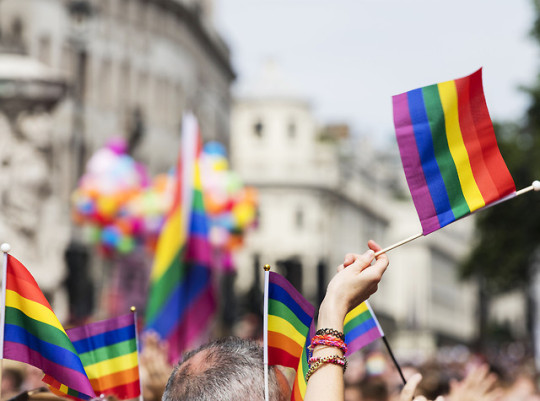
The Story Behind the Rainbow Flag

From Provincetown to San Francisco, and throughout much of the world, the rainbow flag has come to symbolize the power and inclusiveness of queer culture. Less than a half-a-century old, it was created with love and purpose by one man, Gilbert Baker, who through art and design helped to spearhead a movement of enduring pride and acceptance. Baker, a thriving artist and activist until his death last year from cardiovascular disease, is credited with helping to “define the modern LGBT movement” by former California state senator Scott Weiner. Today, the Museum of Modern Art considers his creation to be as recognizable and culturally significant as the ubiquitous recycling symbol. But who was the man behind the flag?
Baker was drawn to art and fashion from an early age. Born in Chanute, Kansas in 1951, he joined the U.S. Army to escape the stifling limitations of his small, conservative town, and was sent, serendipitously, to San Francisco just at the height of the gay rights movement. Here, he quickly threw himself into local culture and activist causes, working on the first-ever marijuana legalization initiative, California Proposition 19, and turning to sewing and graphics as a unique way to resist and protest. During this period, he created banners for gay-rights and anti-war protests, becoming a close friend of San Francisco supervisor Harvey Milk.
Spurred on by his community, Baker began to search for a symbol that could be used in the gay rights movement. The existing emblem, the pink triangle emblazoned on prison uniforms in Nazi Germany, was seen as too dark. “Artie Bresson, the filmmaker who created GAY USA, pushed Gilbert to come up with a symbol. He came upon the idea of a flag,” said Charley Beal, a longtime friend of Baker who currently oversees his estate. Beal explains that the 1976 bicentennial’s use of the American Flag was an important inspiration. “Soon after, Gilbert was dancing at the Cow Palace with Cleve Jones and, amidst the swirl of colored lights, he was overwhelmed with the diversity of people out dancing and came up with the idea of the rainbow flag. I believe there was LSD involved.”
“He had a very deep understanding of history and politics, and had quite an intellect to go along with the drama and glitter.”
In an attic of a San Francisco gay community center, Baker began to work with a band of volunteers and friends to dye and sew the first rainbow flags, the originals including eight colors representing different aspects of the community: sex, life, healing, sunlight, nature, magic/art, serenity, and spirit. Later, Baker removed pink (sex) and turquoise (magic/art) because those fabrics were harder to come by, leaving behind panels of red, orange, yellow, green, blue and purple to act as a universal beacon of pride for the LGBTQ community.
“Cleve Jones helped get the money from the parade committee for the flags,” continued Beal. “Fairy Argyle was the ‘queen of tie-dye’ who instructed him on proper dying techniques.” Others helped with the endless ironing. On June 25th, 1978 Baker and his community hoisted their banners in United Nations Plaza to fete that year’s San Francisco Gay Freedom Day Parade.
“We needed something beautiful, something from us,” Baker later said. “The rainbow is so perfect because it really fits our diversity in terms of race, gender, ages, all of those things. Plus, it’s a natural flag—it’s from the sky!”
“He was very delighted and excited that he had achieved his vision,” explained Cleve Jones, one of Baker’s closest friends and the mastermind behind AIDS Memorial Quilt project. “Rainbows have been used as long as people have been creating art. But it was Gilbert, and Gilbert alone, who imagined the rainbow flag as the symbol of the people now called the LGBTQ. It was his sole mission on this planet to spread that sort of symbol around the world.”
Over the decades, nothing brought Baker greater joy than seeing photographs of his flags in “unexpected” cities, from Moscow to Beijing and Havana. Gilbert, as friends described him, could be “quite difficult, quite challenging, often opinionated and quite imperious,” but with a gentle, caring side. “He was one of the most intelligent people I’ve ever known,” Jones told us. “He had a very deep understanding of history and politics, and had quite an intellect to go along with the drama and glitter.”
After the success of the rainbow flag, Baker began working for the Paramount Flag Company, his work catching the eye of then-mayor Dianne Feinstein, who later commissioned him to design flags, banners, and materials for her inaugural ceremony. Afterwards, Gilbert went on to create flags for the presidents of France, Venezuela, and the Philippines, the King of Spain, and numerous Gay Pride events across the country. But one of his proudest moments was when he designed flags for the 1984 Democratic National Convention.
In 1994, Baker moved to New York City where he crafted what, at the time, was the world’s largest flag, a mile in length, which was later carried by 5,000 people in celebration of the 25th anniversary of the Stonewall Riots. In 2003, to celebrate the Rainbow Flag’s 25th anniversary, Baker outdid his own record, crafting a gigantic flag for Key West Pride that stretched from the Gulf of Mexico to the Atlantic Ocean, and was later cut into sections and distributed across more than 100 cities around the world.
“I think Gilbert’s lasting importance is that he created a symbol of hope and inclusion for an oppressed minority at a time when their efforts at liberation were new,” said Beal. “He then worked tirelessly for almost 40 years to ensure that this symbol would be recognized and understood worldwide.”
“At that time, and in that location, it was an act of courage to display this symbol.”
“The rainbow flag has become such a potent and immediate symbol of pride and solidarity with the LGBTQ community,” says Tim O’Brien, Assistant Director of Exhibitions at the SFO Museum
, which currently has up an exhibit of Baker’s work. “Many of us here in the San Francisco Bay Area take it for granted, as if the symbol has always been with us and has always been easily displayed. When I was growing up in a smaller town outside the immediate Bay Area, the flag made a tremendous impact. Just seeing it flying in front of a home or as a car’s bumper sticker immediately indicated that this person was a member of a tribe of sorts. At that time, and in that location, it was an act of courage to display this symbol.”
Baker’s flag has also left an impression on younger members of the LGBTQ community. Jordan Eagles, 41, is an artist whose work highlights the plight of gay men who pursue blood donation. In the United States, gay men must remain celibate for a full year before being eligible to donate, which most members of the community see as discrimination, given advanced screening processes. Like Baker, Eagle uses art and design to combat oppression and celebrate queer culture. “I don’t remember the first time I saw a pride flag. I feel like it has been in my consciousness forever. I haven’t always found it to be visually appealing, yet I have always understood that it stands for something good, and that is the most important. Gilbert Baker’s flag is iconic and a symbol of gay pride and probably will be forever.”
Mike Devlin, manager of the Blood Equality, a pro bono campaign by FCB Health, is a fellow artist who’s been working with Eagle to fight the blood ban, both legally and ideologically. “Our message is, if we’re serious about LGBTQ rights, it’s time to get serious about Blood Equality. And selectively choosing some rights to support, while ignoring others, does not equate to actual support.” So far, Devlin and Eagles’ work has garnered praise and press and, more importantly, brought the government to the table to discuss and advance policy. “We’re in the midst of hopefully executing research and studies that will spark the conservative (i.e. slow) decision makers to action, providing the evidence they say they need to lift the ban.”
While Devlin is pleased with the campaign’s successes, he realized that he needed an easily recognizable signifier to serve as an icon for this struggle. Inspired by Baker, he has helped to conceptualize and create BLOOD FLAGS, a series of all-red banners to be unfurled at this year’s Blood Donor Day. “The pride flag was the centerpiece of our team’s inspiration: the colors meant to symbolize and unify, yet the colors of the national flags in which LGBTQ men remain stigmatized sits in sharp contrast to the strength of the pride flag below. All in the context of the one color – red – the color of all of our blood. We are the same, one in our blood, yet our blood is not seen as equal.”
Today, a full range of identity-driven flags exist, from those celebrating the leather community to asexuality, to a modification of the rainbow flag itself with additional black and brown stripes added to protest discrimination against people of color in Philadelphia gay bars.
Ultimately, Baker was a street activist who saw the use of protest banners and flags as a political tool. “Gilbert worked his entire adult life to make this happen,” says O’Brien. “I’m sure if he were here today, he’d take understandable pride in this achievement. But I’m guessing he’d read the news about someone somewhere being harassed, abused, evicted, etc. for displaying the rainbow flag, and he’d remind us all that the work remains unfinished.”
0 notes